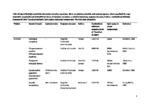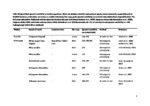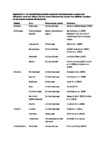Marine artificial light at night: An empirical and technical guide
| dc.contributor.author | Davies, Thomas | |
| dc.contributor.author | Tidau, Svenja | |
| dc.contributor.author | Grimmer, A | |
| dc.date.accessioned | 2021-05-05T15:51:44Z | |
| dc.date.issued | 2021-06-04 | |
| dc.identifier.issn | 2041-210X | |
| dc.identifier.issn | 2041-210X | |
| dc.identifier.uri | http://hdl.handle.net/10026.1/17085 | |
| dc.description.abstract |
<jats:title>Abstract</jats:title><jats:p> <jats:list> <jats:list-item><jats:p>The increasing illumination of our world by artificial light at night (ALAN) has created a new field of global change research with impacts now being demonstrated across taxa, biological ranks and spatial scales. Following advances in terrestrial ecology, marine ALAN has become a rapidly growing research area attracting scientists from across all biomes. Technological limitations, complexities of researching many coastal and marine ecosystems and the interdisciplinary nature of ALAN research present numerous challenges.</jats:p></jats:list-item> <jats:list-item><jats:p>Drawing on expertise from optical oceanographers, modellers, community ecologists, experimental and molecular biologists, we share practical advice and solutions that have proven useful for marine ALAN research. Discussing lessons learnt early on can help in the effective and efficient development of a field.</jats:p></jats:list-item> <jats:list-item><jats:p>The guide follows a sensory ecology approach to marine light pollution and consolidates physics, ecology and biology. First, we introduce marine lightscapes highlighting how these differ from terrestrial ones and provide an overview of biological adaptations to them. Second, we discuss study design and technology to best quantify ALAN exposure of and impacts on marine and coastal organisms including molecular tools and approaches to scale‐up marine ALAN research.</jats:p></jats:list-item> <jats:list-item><jats:p>We conclude that the growing field of marine ALAN research presents opportunities not only for improving our understanding of this globally widespread stressor, but also for advancing fundamental marine photobiology, chronobiology and night‐time ecology. Interdisciplinary research will be essential to gain insights into natural marine lightscapes shaping the ecology and evolution coastal and marine ecosystems.</jats:p></jats:list-item> </jats:list> </jats:p> | |
| dc.format.extent | 1588-1601 | |
| dc.language | en | |
| dc.language.iso | en | |
| dc.publisher | Wiley | |
| dc.subject | Artificial light at night | |
| dc.subject | coastal ecosystems | |
| dc.subject | light pollution | |
| dc.subject | marine ecology | |
| dc.subject | night-time ecology | |
| dc.subject | nocturnality | |
| dc.subject | photobiology | |
| dc.subject | underwater lightscapes | |
| dc.title | Marine artificial light at night: An empirical and technical guide | |
| dc.type | journal-article | |
| dc.type | Review | |
| dc.type | Journal | |
| plymouth.author-url | https://www.webofscience.com/api/gateway?GWVersion=2&SrcApp=PARTNER_APP&SrcAuth=LinksAMR&KeyUT=WOS:000670633100001&DestLinkType=FullRecord&DestApp=ALL_WOS&UsrCustomerID=11bb513d99f797142bcfeffcc58ea008 | |
| plymouth.issue | 9 | |
| plymouth.volume | 12 | |
| plymouth.publication-status | Published | |
| plymouth.journal | Methods in Ecology and Evolution | |
| dc.identifier.doi | 10.1111/2041-210X.13653 | |
| plymouth.organisational-group | /Plymouth | |
| plymouth.organisational-group | /Plymouth/Faculty of Science and Engineering | |
| plymouth.organisational-group | /Plymouth/Faculty of Science and Engineering/School of Biological and Marine Sciences | |
| plymouth.organisational-group | /Plymouth/REF 2021 Researchers by UoA | |
| plymouth.organisational-group | /Plymouth/REF 2021 Researchers by UoA/UoA07 Earth Systems and Environmental Sciences | |
| plymouth.organisational-group | /Plymouth/Users by role | |
| plymouth.organisational-group | /Plymouth/Users by role/Academics | |
| plymouth.organisational-group | /Plymouth/Users by role/Researchers in ResearchFish submission | |
| dcterms.dateAccepted | 2021-05-01 | |
| dc.rights.embargodate | 2021-7-6 | |
| dc.identifier.eissn | 2041-210X | |
| dc.rights.embargoperiod | Not known | |
| rioxxterms.versionofrecord | 10.1111/2041-210X.13653 | |
| rioxxterms.licenseref.uri | http://www.rioxx.net/licenses/all-rights-reserved | |
| rioxxterms.licenseref.startdate | 2021-06-04 | |
| rioxxterms.type | Journal Article/Review | |
| plymouth.funder | Artificial Light Impacts on Coastal Ecosystems (ALICE)::Natural Environment Research Council [2006-2012] | |
| plymouth.funder | Artificial Light Impacts on Coastal Ecosystems (ALICE)::Natural Environment Research Council [2006-2012] |





